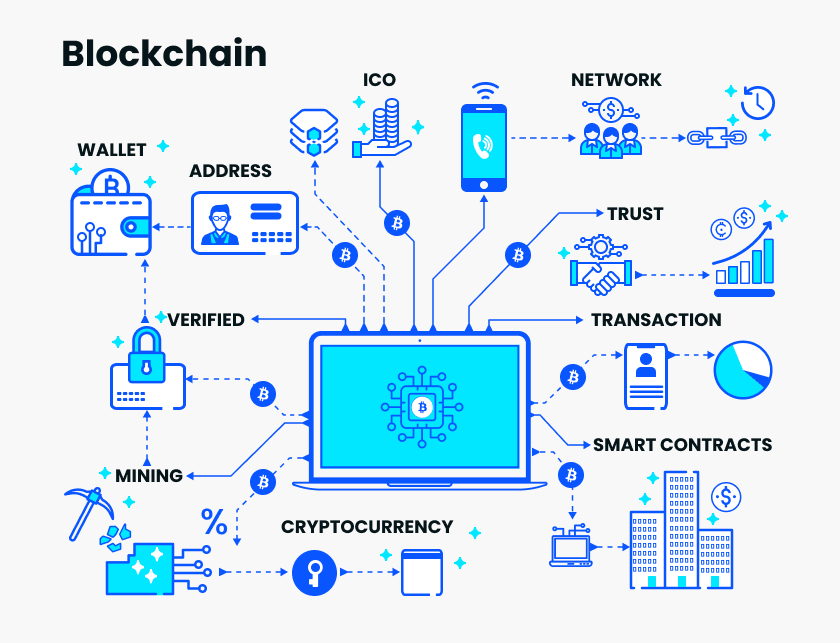Table of Contents
- Introduction
- How Blockchain Works
- Decentralization
- Cryptography
- Blocks and Chains
- Consensus Mechanisms
- Smart Contracts
- Key Components
- Nodes
- Transactions
- Hash Functions
- Public and Private Keys
- Applications
- Cryptocurrency
- Supply Chain Management
- Voting Systems
- Healthcare
- Advantages
- Transparency
- Security
- Efficiency
- Challenges
- Scalability
- Regulation
- Future of Blockchain
- Integration
- Innovation
Introduction
Hey there! Ever heard of blockchain? It’s like the magic sauce behind all the buzz about cryptocurrencies and beyond. In this article, we’re diving deep into the fascinating world of blockchain technology. Buckle up, because by the end, you’ll be talking about hash functions and consensus mechanisms like a pro!
How Blockchain Works
So, what exactly is this blockchain thing? Let’s break it down. At its core, blockchain is all about decentralization, cryptography, and, you guessed it, blocks and chains.
Decentralization
Imagine a giant digital ledger that’s shared across a network of computers. Instead of having one central authority controlling everything, this ledger is decentralized, meaning no single entity has full control. It’s like a potluck dinner where everyone brings a dish to share, ensuring no one person gets to dictate the menu.
Cryptography
Now, let’s talk about security. Blockchain uses advanced cryptography to secure transactions and data. Each block in the chain is encrypted with a unique digital signature, making it nearly impossible to alter or tamper with. It’s like sealing your secret recipe in a vault that only you can access.
Blocks and Chains
Okay, here’s where it gets interesting. Every time a new transaction occurs, it’s grouped together with other transactions to form a block. Once verified, this block is added to the chain in a chronological order, creating a transparent and immutable record of all transactions. It’s like building a digital Lego tower, one block at a time.
Consensus Mechanisms
But wait, how do we ensure everyone agrees on the validity of transactions? That’s where consensus mechanisms come in. These are like the referees of the blockchain world, making sure everyone plays by the rules. From Proof of Work to Proof of Stake, there are various consensus mechanisms keeping the network in check.
Smart Contracts
Now, let’s talk about smart contracts. These are self-executing contracts with the terms of the agreement directly written into code. Once certain conditions are met, the contract automatically executes, eliminating the need for intermediaries. It’s like having a digital lawyer that works 24/7 without charging hefty fees.
Key Components
To understand blockchain better, let’s explore its key components.
Nodes
Nodes are individual computers connected to the blockchain network. They validate and record transactions, ensuring the integrity of the system. Think of them as the loyal guardians of the blockchain realm, tirelessly verifying each transaction.
Transactions
Transactions are the how blockchain technology works. They represent the transfer of assets or information from one party to another. Whether it’s sending Bitcoin or updating medical records, every transaction leaves a trace on the blockchain.
Hash Functions
Hash functions are cryptographic algorithms that convert data into a fixed-size string of numbers and letters. Each block in the blockchain contains a unique hash, linking it to the previous block and forming a secure chain. It’s like giving each block a digital fingerprint, making it easily identifiable.
Public and Private Keys
In the world of blockchain, security is paramount. Public and private keys are used to encrypt and decrypt data, ensuring secure transactions. Your public key acts like your digital address, while your private key is your secret passphrase to access your assets. It’s like having a lock and key system for your digital vault.
Applications
Now that we’ve covered the basics, let’s explore some real-world applications of blockchain technology.
Cryptocurrency
Cryptocurrencies like Bitcoin and Ethereum are perhaps the most well-known applications of blockchain. They enable secure and decentralized peer-to-peer transactions without the need for intermediaries like banks.
Supply Chain Management
Blockchain is revolutionizing supply chain management by providing transparency and traceability across the entire supply chain. From tracking the origin of products to combating counterfeit goods, blockchain technology is reshaping the way goods are produced and distributed.
Voting Systems
Blockchain-based voting systems offer a secure and transparent way to conduct elections. By recording votes on an immutable ledger, blockchain technology helps prevent fraud and ensures the integrity of the electoral process.
Healthcare
In the healthcare industry, blockchain is being used to securely store and share medical records. This not only streamlines data management but also ensures patient privacy and security.
Advantages
Now, let’s talk about the advantages of blockchain technology.
Transparency
Blockchain provides unparalleled transparency by allowing anyone to view the entire transaction history. This fosters trust and accountability, especially in industries where transparency is crucial.
Security
With its decentralized and cryptographic nature, buy bitcoin cash Australia offers robust security against fraud and tampering. Each transaction is verified by multiple nodes, making it nearly impossible to alter the data.
Efficiency
By eliminating intermediaries and automating processes through smart contracts, blockchain increases efficiency and reduces costs. Transactions can be executed faster and with lower fees compared to traditional systems.
Challenges
Of course, blockchain isn’t without its challenges. Let’s take a look at some of the hurdles it faces.
Scalability
As blockchain networks grow larger, scalability becomes a significant concern. Current blockchain platforms struggle to handle high transaction volumes, leading to slower processing times and higher fees.
Regulation
The regulatory landscape surrounding blockchain is still evolving, posing challenges for widespread adoption. Uncertainty about legal frameworks and compliance requirements can hinder innovation in the space.
Future of Blockchain
Despite these challenges, the future of blockchain looks bright. As technology continues to evolve, we can expect to see greater integration and innovation in the blockchain space.
Integration
Blockchain technology is finding its way into various industries, from finance to healthcare to supply chain management. As more companies recognize the potential benefits of blockchain, we’ll likely see widespread adoption in the coming years.
Innovation
From decentralized finance (DeFi) to non-fungible tokens (NFTs), blockchain is constantly evolving with new use cases and applications. As developers continue to push the boundaries of what’s possible, we can expect to see even more innovative solutions built on blockchain technology.














